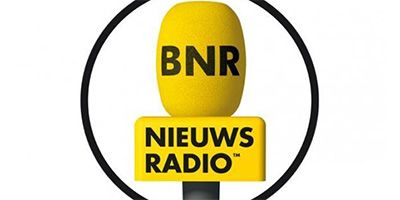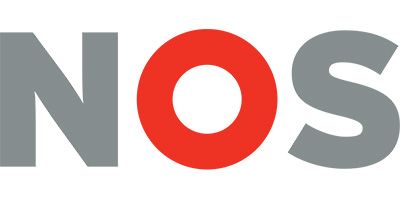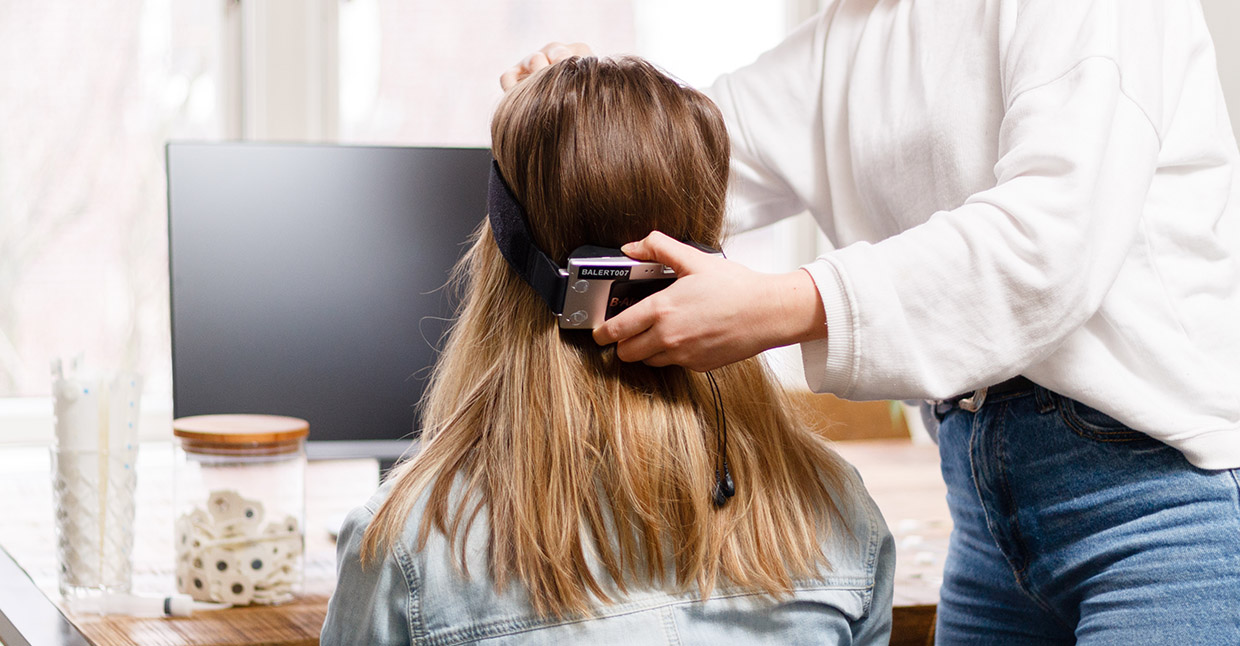
Will our brand-new advertising campaign be a success? What happens if we increase the price of our product by 10 cents? And how can we make our physical or digital shopping environment more user-friendly for the customer? Neuromarketing research is increasingly used to provide better answers to challenging marketing questions like these.
This is not without reason. Brain activity, viewing patterns, and physiological responses contain valuable information about the impact of marketing, often at a level that the respondent themselves is not aware. Thus, neuromarketing offers a more objective and sensitive alternative to classical market research. Neuromarketing not only serves as a measure of success but also indicates which specific components have the most to gain from improvement.
In which marketing areas does neuromarketing research offer the greatest added value? In this blog, we list the four main applications: advertising, retail, usability, and branding.
Table of contents
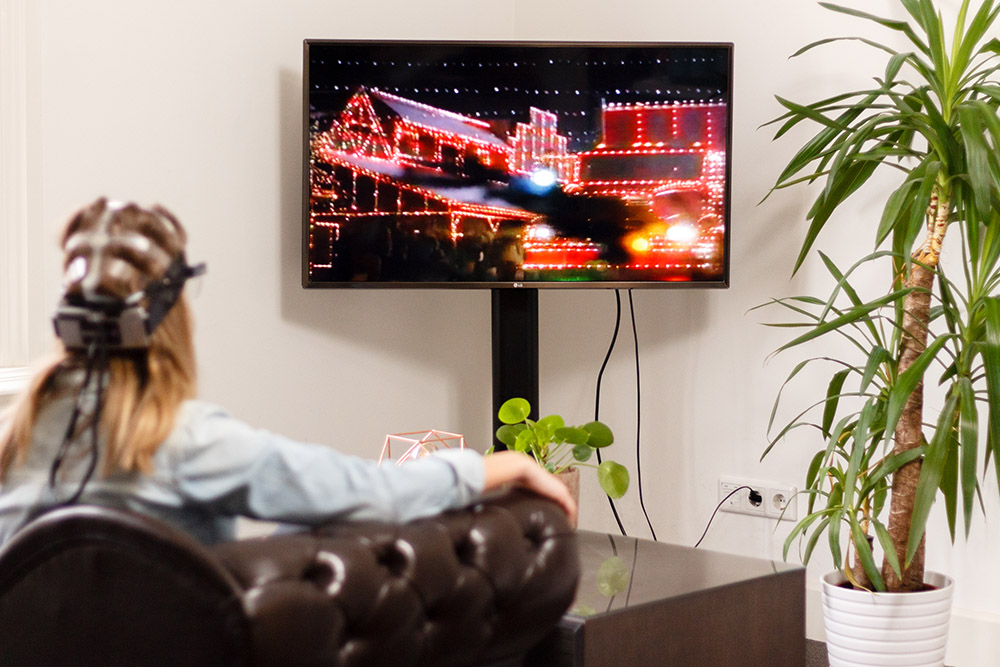
1. Advertising & Communication
Neuromarketing research has its longest history in the application of advertising and communication. Neuro is used in both advertising campaigns and propositions.
1.1. Advertising
Whether you advertise to build brand awareness or convey a specific message, the underlying goal is always the same: sales. Advertising must contribute to sales. However, it is by no means certain that every advertisement actually succeeds in this. Some advertisements do not move the customer at all, and a minority of 20% of the expressions even result in a reduced chance of purchase (Jones, 1995). Neuromarketing research into advertising measures the objective performance from brain activity and compares it with a category-specific benchmark.
Purpose of neuro advertising research
- Does the advertisement score positively on the neurometrics associated with sales and brand building?
- Which specific moments in the advertisement are open to improvement?
Research techniques in neuro advertising research
- Electroencephalogram (EEG)
- Eye Tracking
1.2. Propositions
Would you prefer to buy a bag of crisps with “10% discount” or “10% more content”? Are you more quickly moved by a frightening message or a humorous note? Questions like these touch on the proposition: the way you express your product and message as attractively as possible. A neuro proposition study measures how each message appeals to the brain: is it easy to process and does it prompt action? Essentially an A/B test, but in the brain.
Purpose of neuro proposition research
- Selection of the most effective proposition
Research techniques in neuro proposition research
- Electroencephalogram (EEG)
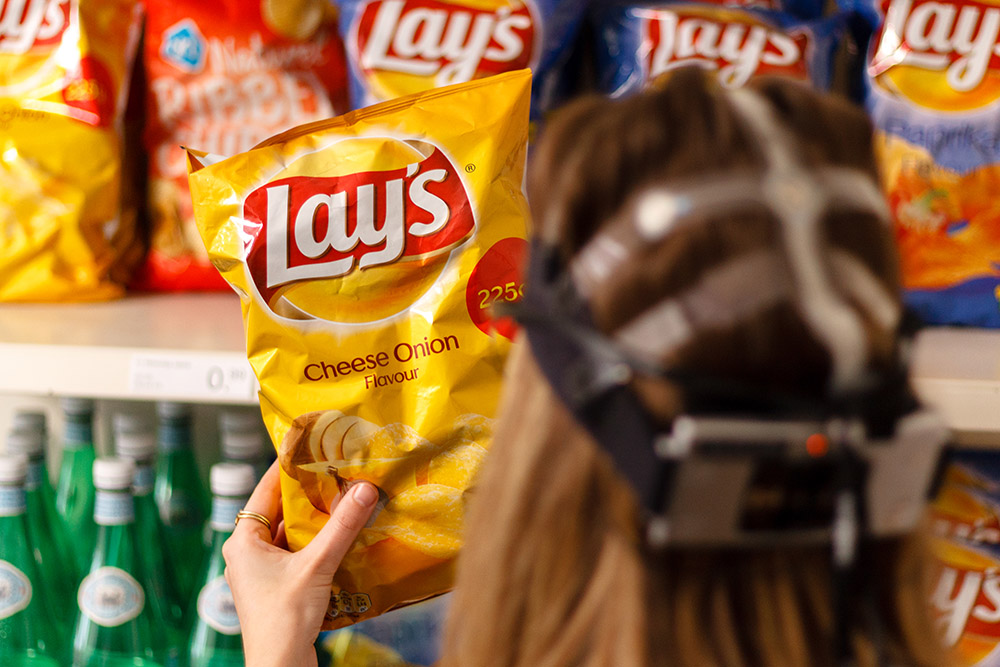
2. Retail
There is no place where we find so many opportunities to influence buying behaviour as in the store itself. Many applications of neuromarketing research focus on the psychological cocktail that takes place here: product & packaging, price, shelf, store layout, and shopping experience.
2.1. Product & Packaging
When our eye catches a product (packaging), our brain determines in mere milliseconds whether we find it attractive – often before the product reaches our consciousness. When launching a new product or adjusting the packaging design of an existing product, thorough research is essential. Neuromarketing research measures that crucial intuitive reaction that products elicit, forming a solid basis for success prediction, selection of the best design, and further optimisation.
Purpose of neuromarketing research into products and packaging
- Prediction of attractiveness on the shelf
- Prediction of standout ability on the shelf
- Prediction of recognisability on the shelf (essential for redesigns)
- Selection of the most promising design route
- Insight into strong and weak design aspects for further optimisation
Research techniques in neuro product and packaging research
- Eye Tracking
- Electroencephalogram (EEG)
Gratis Webinar: "Geur in Gedragsverandering & Marketing"
Ontdek in dit webinar hoe geur ons onbewust stuurt in denken voelen en doen. Met inzichten uit neuro en gedragswetenschappen leer je hoe geur effectief kan worden ingezet in marketing publieke ruimte en gedragsverandering inclusief praktische voorbeelden en tips.
Schrijf je nu gratis in voor deze lunch-webinar op Wednesday 7 May van 12.00 tot 12.45
2.2. Price
Which price point feels best suited to the product? And what is the impact of a price increase? These seem almost impossible questions, as price processing cannot be easily queried. After all, when asked, everything is quickly labelled as 'too expensive'. Neuromarketing price research with EEG offers an objective alternative for this issue for the first time. The method measures the degree of price fit at the millisecond level. By testing a large number of price points, you gain insight into which price value best matches the product.
Purpose of neuromarketing research into prices
- Determine optimal price level
- Indicator of the impact of a price increase
Research techniques in neuro price research
- Electroencephalogram (EEG)
2.3. Shelf
A good shelf layout is brain-friendly; the products are where one intuitively expects them to be. Both the store and the brands benefit from this. Shelf fluency is associated with a higher chance of impulse purchases and a less price-critical attitude. But how do you measure that intuitive search and decision behaviour?
Neuromarketing research allows you to test the processability of different planograms. The respondent interacts with different shelf designs, with viewing patterns and processing in the brain being measured with millisecond precision. The results are often surprising; customers do not follow a rational 'decision tree' but make lightning-fast decisions based on minimal information. With neuro, you discover which product and category factors truly lie behind choice.
Purpose of neuromarketing research into shelf layout
- Optimisation and selection of planogram
- Gain insights into intuitive search patterns
- Map the actual search and choice process of the customer, instead of rational decision trees
Research techniques in neuro shelf research
- Eye Tracking
- Optional: Electroencephalogram (EEG)
2.4. Store Layout
Shopping proves to be particularly stressful for our brains. We are bombarded by thousands of products, signs, and cards clamouring for our attention. Only a fraction of all that information actually reaches the customer. This results in store layout faltering on 'shoppability': people struggle to intuitively find the different categories within the store concept.
A neuro study into store layout measures how customers actually shop. This way, you discover what they see, what they miss, how they navigate, and which hidden stress factors lurk.
Purpose of neuromarketing research into store layout
- Gain insight into the laws of navigation and shopping behaviour
- Measure performance differences per department
- Get concrete improvement points regarding layout, navigation, signage, furniture, paths, and lighting
Research techniques in neuro store research
- Eye Tracking
- Optional: Electroencephalogram (EEG)
2.5. Shopping Experience
The greatest asset that physical retail holds over its digital counterpart is experience. Because physical stores can stimulate all our senses, there are significantly more opportunities to leave a strong emotional impression on the customer. And it is precisely this experience factor that drives (impulse) purchases and return visits.
The emotional ebb and flow during the shopping trip cannot be queried afterwards. Neuromarketing research into shopping experience now allows you to measure the emotional flow during shopping for the first time. This gives you a rich picture of the performance of each department in terms of desire, attention, and stress.
Purpose of neuromarketing research into shopping experience
- Measure performance differences per department in terms of desire, attention, and stress
- Test a renewed store concept against an existing concept or benchmark
Research techniques in neuro shopping experience research
- Eye Tracking
- Electroencephalogram (EEG)

3. Usability
Usability research measures the user-friendliness of an interaction with a website, app, or product. Previously, this was done with research methods where users had to speak their thoughts aloud. Or an interviewer interrupted the user with questions in between.
Neuro usability research eliminates these drawbacks. The user completes a full flow without interruptions, just like at home. Through eye tracking and brain activity, the real hurdles and highlights during the interaction come to light live. Supplemented with an interview afterwards, this creates a complete and realistic picture.
3.1. Website Usability
A website usability study aims to measure user interaction on an online platform, webshop, or otherwise conversion-oriented environment. The user completes a single flow from start to finish, without interruptions. This guarantees a user interaction that is not distorted by overly conscious actions that arise from protocols such as speaking thoughts aloud and interim interviews. The data from eye tracking and brain activity reveal clear improvement points. These provide a substantiated basis for optimisation and A/B tests.
Purpose of neuromarketing research into website usability
- Identify unclear interface elements
- Test information overload
- Discover sources of positive and negative emotion to prevent page exit
Research techniques in neuro usability research
- Eye Tracking
- Electroencephalogram (EEG)
3.2. App Usability
App usage builds up slowly but disappears quickly; it is a significant challenge for an app to secure a place in the daily routine of users. Because the functions and interfaces of apps vary considerably more than those of most websites, a smooth user experience is all the more important. In a neuro app usability study, users perform various tasks in a comfortable and realistic setting. The eye tracking and brain data reveal ambiguities, missed elements, and stress points.
Purpose of neuromarketing research into app usability
- Identify unclear interface elements
- Test information overload
- Discover sources of positive and negative emotion to prevent app exit
Research techniques in neuro app usability research
- Eye Tracking
- Electroencephalogram (EEG)
3.3. Product Usability
From the very first iPhone to the introduction of the beer bottle with a twist-off cap. Products are constantly changing, in large and small ways. But to what extent does the brain adapt to a specific change? Does a product make sense? How would one intuitively use the product? And how can the design be further refined? A neuro product usability study answers questions like these. Users interact with a physically new product, with eye tracking and EEG providing insight into every step of the interaction process.
Purpose of neuromarketing research into product usability
- Performance comparison: is the new design more pleasant than the old one?
- Map intuitive expectations around product use
- Insight into emotional peaks and troughs during interaction
Research techniques in neuro product usability research
- Eye Tracking
- Electroencephalogram (EEG)
4. Branding
There are almost more ways to research brands within marketing research than there are brands. However, many consciously queried metrics hardly correlate with the ultimate goal that every branding activity should provide in the short or long term: more sales.
Brands exist in our brains as a richly branched network of associations with properties, emotions, and the unique visual identity of the brand. It is precisely this neural network that is most decisive for the growth of a brand, but also the most difficult to query with classical research. From neuromarketing, it is possible to quantitatively measure and monitor the strength of brand associations and brand assets.
4.1. Unconscious Brand Associations with Implicit Association Test (IAT)
The stronger our brains associate two thoughts – for example, 'Coca Cola' with 'happiness' – the faster they can be processed simultaneously. This core principle from cognitive psychology forms the basis of the Implicit Association Test (IAT). This test measures the strength of mental associations based on reaction times to a categorisation task.
The IAT has quickly become the gold standard for brand association research. No longer do you have to ask people about their thoughts on a brand – a method plagued by a mix of social desirability and the impossibility of expressing the strength of an association in a number. The IAT measures the pure intuitive strength of an association that can even map subtle differences.
Purpose of neuromarketing research into brand associations
- Brand Tracking: periodically measure a selection of important brand associations
- Advertising campaign test: predict the impact of an advertising campaign on brand associations
- Packaging test: test whether new packaging fits the brand
- Test new logos and other brand assets
Research techniques in neuro product usability research
- Implicit Association Test (IAT)
4.2. Brand Asset Test
The recognisability of a brand is carried by 'Distinctive Brand Assets'. These are the unique properties – often visual, but sometimes also audio or typical creative execution – that make the brand immediately recognisable as 'the brand'. According to leading brand researcher Byron Sharp, it is precisely this recognisability that forms the basis of the brand's sales and growth. Large brands have a lot of brain territory. And to grow, you need to conquer more brain territory.
A Brand Asset Monitor is an online research form to investigate the value of individual brand assets, including the logo, colour spectrum, shapes, typography, slogans, etc. The brand asset monitor places the assets on a strategic grid. Each corner points to a specific strategy to strengthen the underlying assets – and thus your brand.
Purpose of brand asset monitoring
- Discover which brand assets you can change and which you should retain to remain strong, prior to a rebranding
- Discover the semi-strong assets that are full of potential to make your brand more recognisable
- Test the suitability of new brand assets and thus prevent unnecessary investments
Research techniques in brand asset test
- Validated Brand Asset survey that measures unprompted recognition per asset


